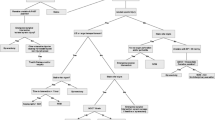Abstract
Background
Nonoperative management (NOM) of blunt splenic injuries is widely accepted, and the use of splenic artery embolization (SAE) has become a valuable adjunct to NOM. We retrospectively review and discuss the complications derived from SAE.
Materials and methods
The medical records of 152 consecutive patients with blunt splenic trauma admitted to our trauma center during a 33-month period were retrospectively reviewed. The patients were managed according to an established algorithm. The record review focused on the method of patient management (operative versus nonoperative) and use of SAE. The complications encountered following SAE are discussed in detail.
Results
Altogether, 73 patients underwent emergency surgery (58 splenectomies, 15 splenorrhaphies), and 79 patients had NOM. Of the 79 patients with NOM, 58 were successfully treated; 2 patients required splenectomy after 24 hours. The remaining 21 patients had SAE, including 18 distal and 3 proximal embolizations. Major complications occurred in 28.5% of the SAE-treated patients and included total splenic infarction, splenic atrophy, and postprocedure bleeding. Minor complications occurred in 61.9% of the patients and included fever, pleural effusion, and partial splenic infarction.
Conclusion
SAE is considered a valuable adjunct to NOM in the treatment of blunt splenic injuries; however, risks of major and minor complications do exist, and SAE should be offered with caution and followed up appropriately.




Similar content being viewed by others
References
Velmahos GC, Toutouzas KG, Radin R, et al. (2003) Nonoperative treatment of blunt injury to solid abdominal organs: a prospective study. Arch Surg 138:844–851
Nix JA, Costanza M, Daley BJ, et al. (2001) Outcome of the current management of splenic injuries. J Trauma 50:835–842
Peitzman AB, Heil B, Rivera L, et al. (2000) Blunt splenic injury in adults: Multi-institutional Study of the Eastern Association for the Surgery of Trauma. J Trauma 49:177–189
Pachter HL, Guth AA, Hofstetter SR, et al. (1998) Changing patterns in the management of splenic trauma: the impact of nonoperative management. Ann Surg 227:708–719
Papadimitriou J, Tritakis C, Karatzas G (1976) Treatment of hypersplenism by embous placement in the splenic artery. Lancet 11:1268–1170
Stanley P, Shen TC (1995) Partial embolization of the spleen in patients with thalassemia J Vasc Interv Radiol 6:137–142
Sclafani SJ, Shaftan GW, Scalea TM, et al. (1995) Nonoperative salvage of computed tomography-diagnosed splenic injuries: utilization of angiography for triage and embolization for hemostasis. J Trauma 39:818–827
Davis KA, Fabian TC, Croce MA, et al. (1998) Improved success in non-operative management of blunt splenic injuries: embolization of splenic artery pseudoaneurysm. J Trauma 44:1008–1015
Hagiwara A, Yukioka T, Ohta S, et al. (1996) Nonsurgical management of patients with blunt splenic injury: efficacy of transcatheter arterial embolization. AJR Am J Roentgenol 167:159–166
Dent D, Alsabrook G, Erickson BA, et al. (2004) Blunt splenic injuries: high nonoperative management rate can be achieved with selective embolization. J Trauma 56:1063–1067
Haan JM, Bochicchio GV, Kramer N, et al. (2005) Nonoperative management of blunt splenic injury: a 5-year experience. J Trauma 58:492–498
Omert LA, Salyer D, Dunham M, et al. (2001) Implications of the “contrast blush” finding on computed tomographic scan of the spleen in trauma. J Trauma 51:272–278
Schurr MJ, Fabian TC Gavant M, et al. (1995) Management of blunt splenic trauma: computed tomographic contrast blush predicts failure of nonoperative management. J Trauma 39:507–513
Benedict CN, Evan PN , Manuel PM, et al. (2004) Contrast extravasation predicts the need for operative intervention in children with blunt splenic trauma. J Trauma 56:537–541
Shanmuganathan K, Mirvis S, Boyd-Kranis R, et al. (2000) Nonsurgical management of blunt splenic injury: use of CT criteria to select patients for splenic arteriography and potential endovascular therapy. Radiology 217:75–82
Haan J, Scott J, Boyd-Kranis RL, et al. (2001) Admission angiography for blunt splenic injury: advantages and pitfalls. J Trauma 51:1161–1165
Haan JM, Biffl W, Knudson MM, et al. (2004) Splenic embolization revisited: a multicenter review. J Trauma 56:542–547
Gaarder C, Dormagen JB, Eken T, et al. (2006) Nonoperative management of splenic injuries: improved results with angioembolization. J Trauma 61:192–198
Smith HE, Biffl WL, Majercik SD, et al. (2006) Splenic artery embolization: have we gone too far? J Trauma 61:541–544; discussion 545–546
Moore EE, Shackford SR, Pachter HL, et al. (1989) Organ injury scaling: spleen, liver and kidney. J Trauma 29:1664–1666
Ekeh AP, McCarthy MC, Woods RJ, et al. (2005) Complications arising from splenic embolization after blunt splenic trauma. Am J Surg 189:335–339
Fang JF, Chen RJ, Lin BC, et al. (2003) Liver cirrhosis: an unfavorable factor for nonoperative management of blunt splenic injury. J Trauma 54:1131–1136
Bessoud B, Denys A (2004) Main splenic artery embolization using coils in blunt splenic injuries: effects on the intrasplenic blood pressure. Eur Radiol 14:1718–1719
Killeen KL, Shanmuganathan K, Boyd-Kranis R, et al. (2001) CT findings after embolization for blunt splenic trauma. J Vasc Interv Radiol 12:209–214
Author information
Authors and Affiliations
Rights and permissions
About this article
Cite this article
Wu, SC., Chen, RJ., Yang, A.D. et al. Complications Associated With Embolization in the Treatment of Blunt Splenic Injury. World J Surg 32, 476–482 (2008). https://doi.org/10.1007/s00268-007-9322-x
Published:
Issue Date:
DOI: https://doi.org/10.1007/s00268-007-9322-x




